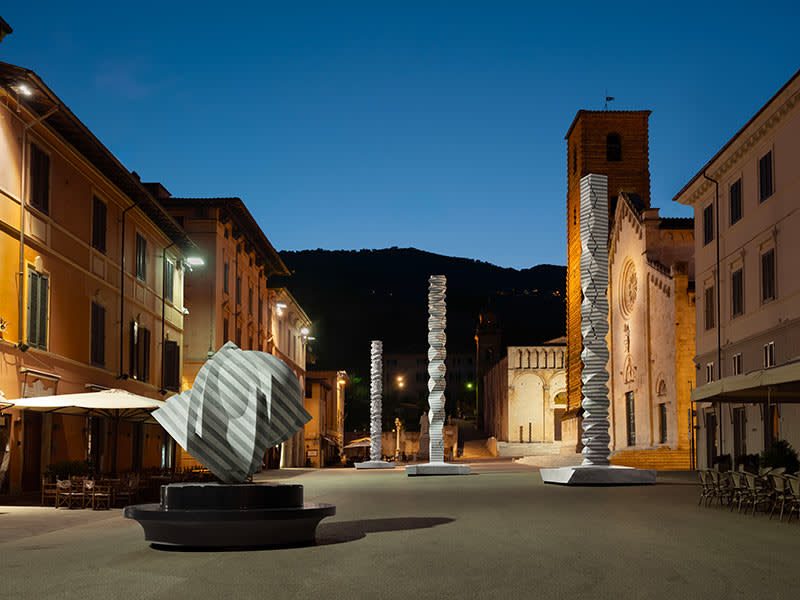Park Eun Sun talks about his Pietrasanta
On the occasion of the summer's beautiful monographic exhibition, we met with the featured artist
Against the backdrop of this summer’s wonderful solo show in the heart of Pietrasanta, born from the collaboration of the Municipality with the Contini Art Gallery in Venice, we met the artist responsible for the exhibition, Park Eun Sun.
Three Infinite Columns stand in Piazza Duomo, symbolising suffering on the one hand, and reconstruction and rebirth on the other. Other works greet locals and visitors at the entrance to Piazza Carducci, like a prelude to the spectacular installation inside the church of Sant’Agostino where columns of hollow marble spheres are illuminated in the austere semi-darkness, marking another stage in Park’s experimental journey.
 Park Eun Sun, L'Eredità della Scultura ©NICOLA GNESI
Park Eun Sun, L'Eredità della Scultura ©NICOLA GNESIYou arrived in Pietrasanta in 1993 as an unknown young artist. Today Pietrasanta celebrates you as one of the world’s leading sculptors. How are you feeling right now?
I can’t imagine starting my artistic career in 1993 in any other place. Pietrasanta provided fertile ground for my growth, and the support of the local community has been fundamental for my development. For this reason I don’t consider this success as my own personal achievement, but rather as a recognition shared with all the people I work with and who support me on a daily basis.
“Suffering begets beauty”. These are your words, and they also describe your marble sculptures, wounded yet perfect. In art, and even more so in life, how can we turn pain into something that improves us?
I believe that once we’ve learned to handle anger and pain, each individual finds their own way of channelling these feelings in positive expressions that can be healing. Personally, I’ve found this balance by splitting and breathing life into primitive geometric forms like the sphere and the prism. The cracks I create in my works harmoniously reunite the two-tone nature of the sculptures, symbolising human dualism. The breaks are clean and precise, almost as if made in a single material, and this creates an effect of continuity and contrast that represents the different facets of human experience.
Your professional growth in Italy hasn’t always been easy. What drove you to keep going?
I still have a very clear memory of landing in Italy. My desire to work with marble - the very same marble used by the great artists of the past - had completely blotted out the fact that I didn’t speak a word of Italian and didn’t have enough money to get by. I was married at the time, and my wife was pregnant with our first child. There’s no doubt that one of the main things that gave me the strength to carry on was my family. My wife, who still supports me in all my difficulties and important moments, has been an essential pillar. Her presence and support were inestimable during those first extremely challenging years. Another thing that made me determined not to give up was my dream. I learned to set myself one small goal at a time, for example, with the height of my columns. I’d say to myself: “A year from now I’ll make a two-metre column, in another two years maybe I’ll be able to buy materials for a three-metre one…” and so on. That was one of many goals. I’m currently building a new workshop/atelier, where one day I’d like to help young artists with selected exhibitions, to give them a chance. These small goals allowed me to keep hope and motivation alive. Every goal achieved, however small, was a step towards fulfilling my dream. Today, everything I make is a tribute to those early years of struggle and hope, and I continue to work with the same passion and dedication that brought me here.
Do you still live in Versilia?
There’s a unique synergy between my art and life in Pietrasanta. Here, every street, every building and every corner tells a story, and these stories are intertwined with my work, making it richer and more profound. With its cultural heritage and its vibrant artistic community, Pietrasanta is the perfect place to continue developing my practice and exploring new creative frontiers. I can’t imagine living and working anywhere else, because I’ve found my place in the world here, surrounded by people who share my passion; my children have grown up here, as has my love of art.
Do you choose the marble for your sculptures yourself?
Of course; the choice of marble is vitally important to me. As you’ll have noticed, my sculptures have cracks, which symbolise release and liberation. Even these cracks need to follow well-defined paths to retain the desired control. Seeing and touching the material allows me to perceive these pathways precisely, and that’s how the harmony of the piece comes about.
Tell us about a favourite place in Versilia
Every part of Versilia has its special thing, and we’re truly blessed to have the sea and the mountains so close. But if I had to choose a favourite place, mine would definitely be Bar Michelangelo. For the past 31 years, I’ve stopped by for a coffee every day, before going to work. It’s become an essential ritual, a moment of peace and reflection before diving into my creative day.
















